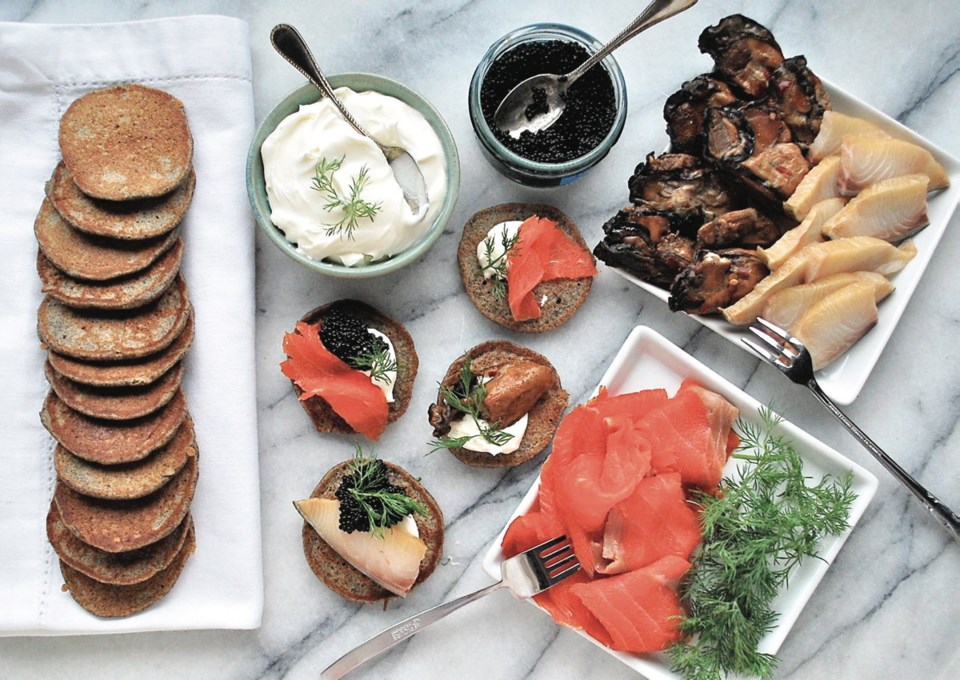The Academy Awards are on Sunday and if you’re hosting a viewing party, you might want to serve decadent bites to nosh on.
If you’re looking for something you can prepare in advance, make blini.
According to the New Food Lover’s Companion, blini were first served in Russia.
In Russian, blini is a small savoury pancake served with such things as butter, herring, smoked fish and chopped hard-cooked egg, according to The Oxford Companion to Food, which notes that in colloquial English, blini can serve as both the singular and the plural.
Traditionally, the batter for blini is yeast-risen and contains such ingredients as buckwheat flour, egg yolks and beaten egg whites.
Before creating my recipe, IÂ reviewed numerous others and no two were exactly the same, with varying proportions of eggs, flour and yeast. That did not surprise me because blini have been made for eons.
My version is a hybrid of a few of those recipes. I prepared and served them as an appetizer, as is often done in North America. About five centimetres wide, my mini blini can be enjoyed in one or two bites as you would a canapé.
You can make the blini many hours before needed, as noted in the Options part of the recipe.
I served the blini with toppings such as B.C. smoked salmon, sablefish and oysters, crème fraîche and small sprigs of dill.
The recipe makes about 60 blini. If that’s too many, any leftovers will freeze well, at the ready to thaw and enjoy.
I did not provide exact amounts for the toppings, because that depends on how many blini you plan to serve, and whether you serve them with all the suggested toppings or just a few. In the Note section of the recipe, I do provide some guidelines, though.
Blini with Assorted Toppings
Tender yet sturdy blini you can top with such things as smoked seafood, crème fraîche and dill. The blini go great with B.C. sparkling wine.
Preparation time: 30 minutes, plus batter rising time
Cooking time: About two minutes per batch of blini
Makes: About 60 blini
1/2 cup buckwheat flour (see Note 1)
1/2 cup all purpose flour
1 1/4 tsp active dry (traditional) yeast
1 Tbsp sugar
1/4 cup butter
1 cup homo (whole) milk
1/4 tsp salt
2 large egg yolks
2 large eggs whites
• toppings to taste, such as sliced smoked salmon, sliced smoked albacore tuna, sliced smoked sable fish, smoked B.C. oysters, crème fraîche or sour cream, lumpfish or other caviar or salmon roe, fresh dill sprigs or snipped chives and/or finely diced red onion (see Note 3)
Place flours, yeast and sugar in a medium-sized bowl.
Place the 1/4 cup butter in a small pot and set over medium heat. Heat butter until just melted. Remove pot from the heat and mix in the milk.
Test the milk mixture and if it’s lukewarm, whisk into the flour mixture. If the milk mixture is hot, let it cool until lukewarm before whisking into the flour mixture.
Cover the bowl with plastic wrap and let stand in a draft-free, warm, room temperature place about 60 to 90 minutes, or until the batter has doubled in volume.
When it has doubled in volume, add the egg yolks and salt to the batter and whisk to combine (the batter will deflate and that’s OK).
In a second bowl, or bowl of your stand mixer fitted with the whip attachment, beat the egg whites until stiff peaks form. Add the beaten egg whites to the batter and use a spatula to gently, but thoroughly, fold them in.
Heat a non-stick griddle or large skillet set to, or over, medium, medium-high heat. Brush the surface of the griddle or skillet lightly with butter. Pour on, in batches, 1 Tbsp amounts of the batter, leaving an inch or two of space between each blini. Flip blini once they begin to bubble on top. Cook one minute on the other side.
Transfer cooked blini to a large baking sheet. Turn the remaining batter into blini as you did the first batch and set them on the baking sheet, too (see Eric’s options).
To serve, arrange some of the blini on a platter, board or marble slab. Set your toppings on plates and in bowls and set them beside the blini. Let diners top their blini as desired.
Note 1: Buckwheat flour is sold in bags and in bulk and many supermarkets and bulk food stores.
Note 2: Crème fraîche is sold in tubs in the dairy section of some supermarkets. I used Liberté brand and one tub of it, or tub of sour cream, should provide what you need here. B.C. smoked salmon, sablefish, tuna and oysters are sold at some supermarkets and seafood stores. If the fish you bought was frozen and unsliced, thinly slice it before it’s has completely thawed as it will be easier to neatly do so in that form. When deciding how much to buy, estimate that 100 grams of smoked fish, thinly sliced, should be enough to top 12 blini. B.C. smoked oysters are sold in cans and vacuum packed bags. They are often much larger than imported canned smoked oysters and sometimes half an oyster is enough to top a blini. If you like smoked oysters, get two cans or bags of them and if you don’t use the second can or bag, save it for another time. Caviar and salmon roe are sold in jars at some supermarkets, seafood stores and Japanese food stores. If you plan to top all the blini with caviar or salmon roe, you’ll likely need two jars.
Eric’s options: The blini can be made many hours before needed. After you’ve made them and they’ve cooled to room temperature, tightly cover and keep at room temperature until needed. Any leftover blini could be frozen, to thaw and serve at another time.
Eric Akis is the author of eight cookbooks, including seven in his Everyone Can Cook series. His columns appear in the Life section Wednesday and Sunday.



